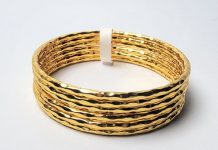The art of tapestry weaving is a method of fabric design and, from this, a term applied to such fabrics themselves. Tapestry differs from embroidery in that it stitches the design into the warp and weft threads in the making of the fabric. In contrast, embroidery sets the design on a woven fabric. It differs from other forms of hand-weaving significantly: in tapestry-weaving, the warp threads are entirely covered by the weft, and in tapestry-weaving, the weft threads of the pattern cannot be shot with a shuttle across the warp.
The thread can only carry so far when it meets another color in the pattern; it must be put on a small bobbin, carefully and loosely, by hand. This primitive weaving method cannot be done mechanically. Machine-made tapestries are not tapestries. Real tapestry is manufactured today as it has been for thousands of years, and its makers are artist-craftsmen.
It may be mentioned here parenthetically that the celebrated Bayeux Tapestry is not a tapestry; it is an exceedingly interesting piece of embroidery. The tapestry loom is extremely simple, being little more than a frame to hold the warp threads. It has a device for lifting them while the weft threads of the pattern are worked on.
The large tapestry loom may stand upright (high warp) or be horizontal (low warp). The weaver works according to a colored cartoon fastened to his loom. In order to manage his many threads, he must fold his fabric upside down, seeing the right side in a fixed mirror.

He must exercise not only great care but personal ingenuity and artistic ability in his shading, and in the picture tapestries, which include the majority of tapestries, he must work skillfully with many colors: the chromatic prism composed for the Gobelins contains 14,420 different tones. The high-warp method, also known as haute-lisse, used by the Gobelins is generally considered better.
However, the horizontal loom with the lowest warp is quicker; this is the loom used at Beauvais. In weaving tapestries, open slits occur in the fabric where pattern lines run parallel to the warp, and these are treated in different ways: in the medieval tapestries of Flanders and France, they were usually sewn up after the fabric had been taken from the loom; present-day tapestries are ordinarily made with some method of interlocking the pattern threads so that the open slits do not occur.
As with all woven products, the number of warp threads for a given surface varies. On this number, the fineness or coarseness of the tapestry depends. The usual range is 10 to 30 threads per inch. Tapestry weaving is an ancient craft. It can be traced back to the Egyptians of the middle of the dynastic period, about 2000 B.C.
The earliest specimens existing to which an accurate date can be assigned are three pieces, now in the museum at Cairo, which were found in the tomb of Thothmes IV, who reigned from 1420 to 1411 B.C. The most important “primitive” pieces existing, however, are the Coptic tapestries of the 4th to the 8th centuries A.D. and the Peruvian work of the 14th to the 17th centuries.
The Natural History Museum in New York and the Museum of Fine Arts in Boston have excellent collections of these early tapestries. The most influential era of tapestry weaving in Europe came with Flemish development. How and when it was first introduced and adopted in Flanders is unknown, although it was apparently brought from the East. By the beginning of the 14th century, however, tapestry weaving, always an art, had become in Flanders a flourishing industry as well. During that century, Flanders became a possession of the enormously wealthy and powerful Dukes of Burgundy.
This event had two effects upon tapestry weaving: it gave the art the richest possible patronage in the Burgundian court and brought it into close contact with France, to whose royal house the Burgundian Dukes belonged. Practically all European tapestries, after the classic culture was ended by the Dark Ages, owe their origins to Flemish weavers. Their tapestries were sold everywhere, as were they themselves; it would seem they received orders from every country.
Only in Flanders did the tapestry-weaving show develop alongside a subsequent show after Flanders, probably because the two countries were so closely linked geographically and politically. In 1477, indeed, France captured and annexed the famous weaving center of Arras. This was the first capital of tapestry weaving and so intimately associated with the art that, in England especially, the words “tapestry” and “arras” became common nouns.
After that, Brussels became the world’s foremost Flemish tapestry center. At the end of the 18th century, tapestry weaving was abandoned in Flanders. In France, the Gobelin factories in Paris and Beauvais were founded, and the factory at Aubusson was under royal patronage in the 17th century. The two first names are still national factories for handmade tapestries and are successful, renowned, and working according to their traditional methods. In Aubusson, there are now many private factories, and although some have turned to machine weaving, handwork is still done there.
Germany and Scandinavia had tapestry weaving as a domestic craft in the Middle Ages. In Italy, although tapestry was fine, its popularity did not become as popular as in other countries. Italian genius appears better suited to fresco painting. The English imported tapestries from France and established home factories in the 16th century.
Where the word “factory” is used here, it must be understood as handwork, not machine work. The famous tapestries of the 14th century remain a few individual pieces, but only one series, the famous Apocalypse set in the cathedral of Angers; this was woven by Nicholas Bataillc in Paris after cartoons by Hennequin of Bruges.
From the 15th century onward, many beautiful tapestries remain; a late Gothic masterpiece is the celebrated Mazarin Tapestry acquired by J. Pierpont Morgan, a very intricate and marvelously lifelike work. Probably the most famous tapestries in the world are the celebrated Acts of the Apostles in the Vatican, for which Raphael made the cartoons; they were woven in Brussels in the early 16th century.
The early 20th century saw a notable increase in tapestry weaving interest in almost every country. Modern tapestries are made according both to traditional pictorial patterns and in pure design arrangements. Methods are both traditional and “modified.” But the age-old distinctions between tapestry and embroidery, between tapestry and other kinds of weaving, and the age-old necessity for artistic workmanship remain unchanged.
Read More: The Art of Draping: Styling Tips for Organza Sarees







